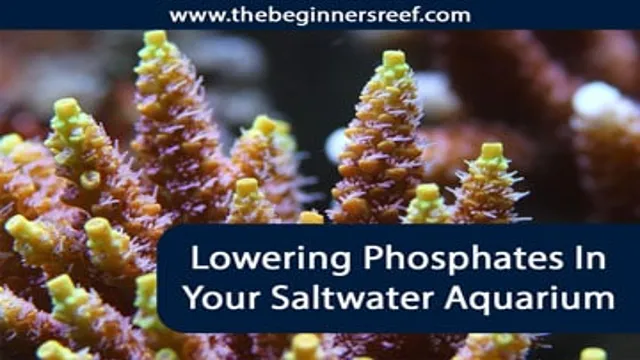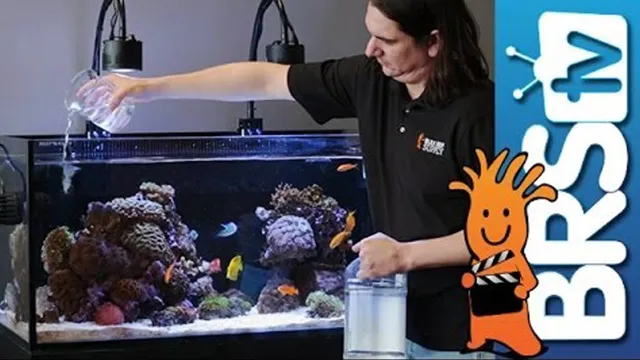Are you struggling to maintain a healthy and thriving aquarium? High levels of phosphates could be the culprit. Phosphates can come from a variety of sources like fish waste, uneaten food, and even tap water. When levels get too high, it can lead to algae overgrowth and harm your aquarium inhabitants.
But don’t worry, lowering aquarium phosphates is possible with a few simple steps. In this blog, we will explore the causes and effects of high levels of phosphates in your aquarium and discuss effective ways to reduce them. Think of phosphates as junk food for algae.
They feed on it and grow rapidly, making your aquarium look cloudy and unattractive. In addition to its aesthetic effects, high levels of phosphates can also harm your fish and plants. It can lead to poor growth, weakened immune systems, and even death.
To combat high phosphate levels, it is important to test your aquarium water regularly. Once you identify high levels of phosphates, you can take steps to remove them. One effective method is to perform more frequent water changes and use purified water.
You can also use phosphate-removing products or add more aquatic plants to your aquarium. By taking these simple steps, you can lower the levels of phosphates in your aquarium, promote a healthy environment for your fish and plants, and enjoy a beautiful and thriving aquatic space.
Why Lower Phosphates?
If you’re wondering how to lower aquarium phosphates, there are a number of good reasons to do so. Excess phosphates can lead to a variety of issues in your aquarium, including algae blooms and poor water quality. By reducing the levels of phosphates in your tank, you can help create a healthier environment for your fish and other aquatic life.
One way to lower phosphates is by using a phosphate remover product, which can be added directly to your tank or used in your filter. Another option is to reduce the amount of food you feed your fish, since uneaten food can contribute to phosphate buildup. Regular water changes can also help lower phosphate levels and keep your tank clean and healthy.
Whether you’re a new aquarium owner or an experienced hobbyist, it’s important to pay attention to phosphate levels and take steps to keep them under control.
Phosphates and Algae
Phosphates are a common nutrient in both freshwater and saltwater environments, and they play an important role in the growth of aquatic plants and algae. However, too much phosphate can lead to an overgrowth of algae, which can harm the health of aquatic ecosystems by depleting oxygen and blocking sunlight from reaching other plants. While algae are an important part of the food chain, too much can cause imbalances that can harm fish, shellfish, and other aquatic organisms.
As a result, many aquarium owners and water treatment facilities seek to lower phosphate levels through a variety of methods. Lowering phosphates can be done in several ways, including using chemical additives, enhancing biological filtration, reducing feeding to reduce organic waste, and using UV sterilizers to kill algae. Each method has its own advantages and disadvantages, and it is important to consider the specific needs and goals of your aquatic environment before selecting a solution.
For example, chemical additives can be effective in reducing phosphates, but can also harm other animals and plants in the aquarium if not used correctly. Enhancing biological filtration can be a more natural and sustainable approach, but may require more maintenance and time to achieve desired results. Regardless of the method chosen, the importance of maintaining appropriate phosphate levels within aquatic environments cannot be overstated for the health and sustainability of these delicate ecosystems.

Chemical Imbalances
Chemical imbalances in the body can cause a variety of health issues, including mood disorders, fatigue, and even cognitive decline. One way to combat these imbalances is by lowering levels of phosphates in the body. Phosphates are often found in processed foods, so one solution is to focus on whole, natural foods that are free from additives and preservatives.
Another option is to take a phosphate binder, which can help to lower levels of phosphates in the body and promote better overall health. It’s important to speak with your healthcare provider about the best course of action for your individual needs and to make sure that any changes you make to your diet or medication regimen are safe and effective. By addressing chemical imbalances in the body, you can improve your overall wellbeing and enjoy better health and vitality.
Testing for Phosphates
If you want to maintain a healthy aquarium, you’ll need to keep an eye on the phosphate levels in the water. This nutrient is important for plant growth, but too much of it can lead to algae blooms and other problems. The best way to figure out how much phosphate is in your aquarium is by testing the water.
There are a variety of phosphate test kits available on the market, including liquid test kits and test strips. It’s important to follow the instructions carefully and record your measurements accurately. Once you know how much phosphate is in your aquarium, you can take steps to lower it if necessary. (See Also: How to Get Rid of Surface Protein in Your Aquarium and Maintain Clear Water)
This could include reducing feedings, increasing water changes, using phosphate-removing media or chemicals, or adding plants that consume phosphate. By keeping a close eye on your phosphate levels and taking action when necessary, you can help ensure that your aquarium remains healthy and vibrant.
Water Testing Kits
When it comes to testing the quality of your water, phosphates are an important factor to consider. High levels of phosphates can lead to increased algae growth, which can harm aquatic life. Luckily, there are water testing kits available that can easily measure the level of phosphates in your water.
These kits typically come with test strips or reagents that change color based on the level of phosphates present. By comparing the color change to a chart provided with the kit, you can determine the phosphate concentration in your water. It’s important to regularly test your water for phosphates to ensure the health of your aquatic environment.
So, next time you’re testing your water, don’t forget to check for phosphates using a reliable testing kit.
Interpreting Results
When testing for phosphates, the interpretation of the results can tell you a lot about the quality of your water. If the test shows a high level of phosphates, it could indicate that there is an excess of nutrients in the water. This is a common problem in bodies of water that are near agricultural areas or are affected by stormwater runoff.
These excess nutrients can promote the growth of algae and other aquatic plants, which can lead to reduced water clarity and oxygen levels. On the other hand, a low level of phosphates indicates that there is a lack of nutrients in the water, which can limit the growth of aquatic life. It is important to consider other factors when interpreting phosphate test results, such as pH levels and temperature, as they can also impact water quality.
By regularly testing and interpreting phosphate levels in your water source, you can better understand and address potential environmental issues.
Reducing Phosphate Levels
Aquarium phosphates can have harmful effects on fish and plant life if not managed properly. Thankfully, there are steps you can take to lower phosphate levels in your aquarium. First and foremost, you should ensure that you’re not overfeeding your fish.
Excess uneaten food can create excess waste, which in turn increases phosphate levels. Additionally, regularly cleaning your aquarium, including gravel vacuuming, can help remove any built-up debris that may be contributing to high phosphate levels. Using live plants can also help to absorb excess nutrients, including phosphates.
Lastly, consider utilizing a phosphate-removing filtration media, such as activated carbon or phosphate-adsorbing resins, to help absorb any remaining phosphates in your aquarium. By taking these steps, you can help ensure a healthy and balanced aquatic environment for your fish and plants to thrive.
Water Changes
When it comes to maintaining the health of your aquarium, regular water changes are essential. One of the main reasons you’ll want to change out some of the water every few weeks is to reduce the levels of phosphate in the tank. Phosphate is a chemical compound that is produced when fish waste and uneaten food break down.
High levels of phosphate can lead to excess algae growth, which can negatively impact the water quality and harm your fish. By performing routine water changes, you’ll be able to dilute the phosphate levels in your aquarium and promote a healthy environment for your aquatic pets. Remember, keeping up with regular maintenance is the key to a thriving aquarium!
Algae-Eating Fish
If you’re looking for a natural solution to reduce the levels of phosphates in your aquarium, you may want to consider using algae-eating fish. These fish are great at keeping your tank clean and healthy by consuming the excess algae that can cause harmful levels of phosphates. By doing so, they also prevent the growth of new algae and reduce the amount of phosphates produced in your tank. (See Also: How to Get to Monterey Bay Aquarium from San Francisco: The Ultimate Guide)
This approach is not only environmentally-friendly, but it also reduces the need for chemical treatments that can be harmful to your fish and other aquatic life. By introducing algae-eating fish to your aquarium, you can create a natural balance that promotes the well-being of all its inhabitants.
Chemical Treatments
Chemical treatments can be an effective way to reduce phosphate levels in a variety of settings. One popular method is the use of aluminum-based coagulants, which work by binding to phosphates and other contaminants, causing them to form larger particles that can be easily removed from the water. Another common treatment method is the use of iron-enhanced sand filters, which utilize a layer of sand that has been infused with iron particles.
As water passes through the filter, the iron particles react with the phosphates, causing them to form larger particles that can be more easily trapped and removed. While chemical treatments can be effective, it’s important to remember that they should always be used in conjunction with other strategies like reducing nutrient run-off and promoting healthy aquatic ecosystems. By working together, we can help to reduce phosphate levels and protect our water resources for generations to come.
Preventing Phosphate Buildup
Aquarium enthusiasts know the importance of maintaining the phosphates in their fish tanks. High phosphate levels can lead to algae growth, which can hurt fish and plants in the tank. Thankfully, there are steps you can take to keep phosphate buildup at bay.
Firstly, you can reduce the amount of food you feed your fish. Overfeeding can lead to excess waste and, in turn, high phosphate levels. Secondly, examine your water source and improve its quality by using reverse osmosis or deionization systems.
This can help ensure that your water source doesn’t contain excess phosphates. Thirdly, consider investing in a phosphate-removing media. These products help absorb phosphate from the water and prevent it from building up.
By following these simple steps, you can keep your aquarium healthy and your fish happy.
Feeding Habits
When it comes to feeding your aquatic pets, it’s essential to be mindful of potential phosphate buildup in their habitat. This can occur when excess food or waste is left to accumulate in the tank, leading to algae growth and potentially harmful water conditions. To prevent this, consider feeding your fish smaller amounts of food at regular intervals rather than one large feeding.
Additionally, regularly removing any excess or uneaten food from the tank can go a long way in preventing phosphate buildup. When selecting fish food, choose options with low levels of phosphates to further support a healthy environment for your aquatic friends. By being conscious of your feeding habits and taking proactive steps to prevent phosphate buildup, you can help create a thriving and harmonious aquatic habitat.
Cleaning and Maintenance Tips
Regular cleaning and maintenance of your swimming pool is critical in ensuring it remains in optimal condition. One common issue that pool owners encounter is phosphate buildup, which can lead to cloudy water and algae growth. To prevent this, it is essential to keep an eye on phosphate levels by using a test kit and regularly removing debris.
Additionally, investing in a phosphate remover can be helpful in reducing levels and preventing buildup. Another useful tip is to examine your pool chemicals and adjust as necessary, as imbalanced chemicals can contribute to the buildup of phosphates. By taking simple preventative measures, you can keep your pool clean, clear, and free of harmful growth, ensuring a safe and enjoyable swimming experience for you and your family.
Aquatic Plant Balance
Aquatic plant balance is crucial for maintaining a healthy aquatic ecosystem. One of the biggest challenges to aquatic plant balance is preventing phosphate buildup. Phosphates are naturally present in fish waste, uneaten food, and dead plant material.
If not removed, they can accumulate in the water and lead to excessive algae growth, which can suffocate other aquatic vegetation and animals. To prevent phosphate buildup, it’s important to monitor and control the inputs that contribute to phosphate levels. This includes reducing overfeeding and cleaning out uneaten food, regularly removing dead plant material, and controlling fish populations through proper stocking and nutrition.
Additionally, using phosphate-binding products in the aquarium can help prevent excess phosphates from entering the water and promote a more balanced ecosystem. It’s also important to understand the role of aquatic plants in maintaining a healthy balance. Live aquatic plants can actively remove excess nutrients, including phosphates, from the water through the process of photosynthesis. (See Also: How to Bring pH Up in Saltwater Aquarium: Tips and Tricks for Optimal Tank Conditions)
Keeping a variety of plant species in the aquarium can also help prevent any one species from dominating and upsetting the balance. By taking a proactive approach to preventing phosphate buildup and promoting a healthy balance of aquatic plants, we can create a thriving aquatic ecosystem that benefits both our aquatic pets and the environment.
Conclusion
In conclusion, keeping phosphates at a healthy level in your aquarium is paramount for the health and well-being of your aquatic pets. Whether it’s through regular water changes, using a high-quality phosphate remover, or adjusting your feeding habits, there are plenty of ways to keep those pesky phosphates in check. Remember, a little bit of prevention goes a long way – so don’t let those phosphate levels creep up on you! With a bit of diligence and a little bit of effort, you can help ensure that your aquarium remains a healthy, vibrant oasis for all your underwater friends.
So go ahead and dive in – your fish will thank you for it!”
FAQs
What causes high levels of phosphates in aquariums?
High levels of fish waste, overfeeding, and decaying plant matter can cause high levels of phosphates in aquariums.
How can I measure the phosphate levels in my aquarium?
You can use a phosphate test kit to measure the phosphate levels in your aquarium.
What are the consequences of high phosphate levels in aquariums?
High phosphate levels can lead to excessive algae growth, decreased oxygen levels, and overall poor water quality in aquariums.
How can I lower the phosphate levels in my aquarium?
You can lower the phosphate levels in your aquarium by performing regular water changes, reducing the amount of fish food and waste in the tank, and using phosphate-removing filter media or chemical treatments.
Can live plants help lower phosphate levels in aquariums?
Yes, live plants can help absorb excess phosphates in aquariums and help to lower levels over time.
Is it safe to use phosphate-removing chemicals in aquariums?
As long as you follow the instructions carefully and use the correct amount, phosphate-removing chemicals can be safe to use in aquariums.
How often should I test for phosphate levels in my aquarium?
It’s recommended to test for phosphate levels at least once a week, or more frequently if you’re experiencing algae problems or other water quality issues.







